The ex-employee verification market is set to expand from USD 244.7 million in 2025 to USD 499.7 million in 2035, creating an absolute gain of USD 255 million and nearly doubling in size over the ten-year period. The compound annual growth rate (CAGR) of 7.1% reflects a decade shaped by increasing digitization in workforce management, the rising importance of compliance frameworks, and the growing need for systematic background screening in both private and public sectors. Verification has evolved from a support function into a core element of enterprise governance, where accuracy, speed, and security determine organizational risk resilience. Human resources operations are undergoing transformation, integrating employment checks into broader compliance platforms and enterprise-level decision-making.
Between 2025 and 2030, the ex-employee verification market is forecast to grow from USD 244.7 million to USD 317.2 million, a rise of USD 72.5 million, representing 42% of overall expansion. This early phase will be shaped by rapid adoption of advanced verification technologies. Enterprises are increasingly moving away from manual and paper-based processes, adopting AI-driven screening solutions that deliver faster turnaround and higher accuracy. The widespread adoption of remote and contract-based employment models creates demand for platforms capable of handling cross-border and multi-jurisdictional checks in real time. Vendors are focusing on automation and data integration, embedding enhanced security features into their offerings. During this stage, verification solutions will shift from being a value-added service to a baseline requirement in HR operations.
From 2030 to 2035, the ex-employee verification market is projected to accelerate, adding USD 182.5 million in value to reach USD 499.7 million. This second half of the decade will be defined by mainstream integration of verification systems into enterprise resource planning and HR management platforms. The focus will expand to predictive verification capabilities, where analytics anticipate risks before they occur. Blockchain-based employment records and biometric validation methods are expected to strengthen credibility and reduce fraud. Organizations will increasingly seek seamless compatibility between verification technologies and existing HR infrastructure, encouraging partnerships between verification providers and global HR service platforms. Multinational firms will drive demand for unified compliance solutions, streamlining verification across multiple regions and regulatory regimes. Regional imbalances will play a defining role in adoption trends. North America and Europe are expected to lead due to mature compliance frameworks and high outsourcing penetration in HR services. Asia Pacific will emerge as the fastest-growing region, driven by large-scale digitization, a massive workforce base, and tightening corporate governance. Latin America and Africa will show slower yet steady uptake, largely through multinational corporations imposing compliance standards on local operations.
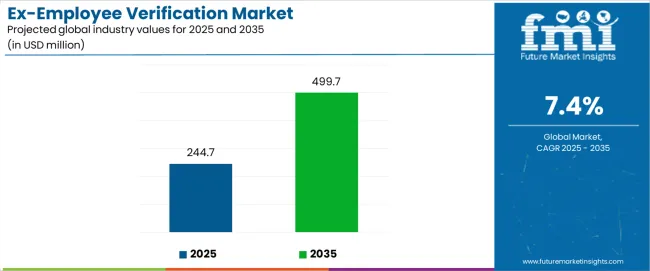
| Period | Primary Revenue Buckets | Share | Notes |
|---|---|---|---|
| Today | Software-based verification systems | 56% | Automated screening, enterprise platforms |
| Service-based verification | 32% | Manual verification, specialized services | |
| Government verification services | 12% | Regulatory compliance, public sector | |
| Future (3-5 yrs) | Advanced software platforms | 48-52% | ai-powered screening, automated workflows |
| Enterprise integration services | 22-26% | HR system integration, API solutions | |
| Government & compliance applications | 15-18% | Regulatory verification, public agencies | |
| SME verification solutions | 8-12% | Small business screening, cost-effective options | |
| Specialized industry services | 6-9% | Financial services, healthcare, education | |
| International verification | 4-7% | Cross-border screening, global compliance |
| Metric | Value |
|---|---|
| Market Value (2025) | USD 244.7 million |
| Market Forecast (2035) | USD 499.7 million |
| Growth Rate | 7.4% CAGR |
| Leading Service Type | Software-Based Verification |
| Primary Application | Large Enterprise Segment |
The ex-employee verification market demonstrates strong fundamentals with software-based verification systems capturing a dominant share through advanced automated capabilities and enterprise application optimization. Large enterprise applications drive primary demand, supported by increasing compliance requirements and corporate risk management modernization initiatives. Geographic expansion remains concentrated in developed markets with established corporate infrastructure, while emerging economies show accelerating adoption rates driven by employment screening industry modernization initiatives and rising regulatory standards.
Design for compliance accuracy, not just speed
Primary Classification: The market segments by service type into software and services, representing the evolution from traditional manual verification processes to sophisticated automated systems for comprehensive employment screening optimization.
Secondary Classification: Application segmentation divides the ex-employee verification market into large enterprises, SMEs, and government, reflecting distinct requirements for verification performance, compliance standards, and operational integration specifications.
Tertiary Classification: Industry segmentation covers financial services, healthcare, technology, manufacturing, and education, while verification types span employment history, reference verification, credential checking, and background screening services.
Regional Classification: Geographic distribution covers North America, Latin America, Western Europe, Eastern Europe, East Asia, South Asia Pacific, and Middle East & Africa, with developed markets leading adoption while emerging economies show accelerating growth patterns driven by employment screening industry modernization programs.
The segmentation structure reveals service progression from traditional manual verification toward sophisticated automated systems with enhanced accuracy capabilities, while application diversity spans from large enterprises to government agencies requiring precision verification solutions.
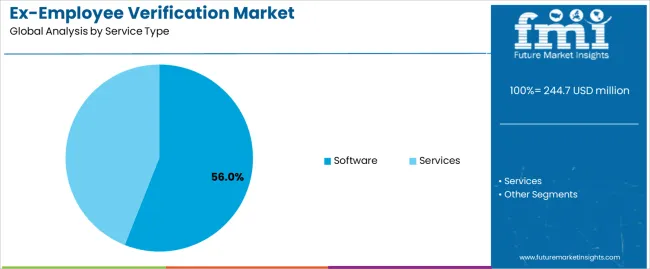
Market Position: Software verification systems command the leading position in the ex-employee verification market with 56% market share through proven automation technologies, including intelligent processing, real-time verification capabilities, and enterprise integration optimization that enable organizations to achieve optimal screening efficiency across diverse corporate and government environments.
Value Drivers: The segment benefits from enterprise preference for automated verification systems that provide enhanced accuracy, operational efficiency, and compliance reliability without requiring manual processing infrastructure. Advanced software processing features enable enhanced data validation, automated reporting, and integration with existing HR programs, where verification performance and compliance assurance represent critical operational requirements.
Competitive Advantages: Software verification systems differentiate through proven automation reliability, intelligent processing characteristics, and integration with established HR management systems that enhance organizational effectiveness while maintaining optimal compliance standards suitable for diverse screening applications.
Key market characteristics:
Service-based verification systems maintain a 32% market position in the ex-employee verification market due to their specialized expertise and personalized service positioning benefits. These services appeal to organizations requiring customized verification solutions with enhanced accuracy profiles for complex screening operations. Market growth is driven by regulated industry expansion, emphasizing specialized verification solutions and compliance assurance through optimized service designs.
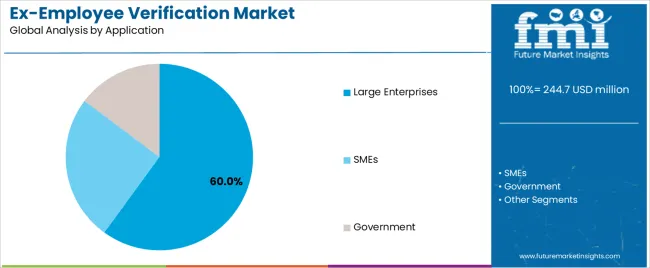
Market Context: Large enterprise applications demonstrate strong growth in the ex-employee verification market with 8.2% CAGR due to widespread adoption of comprehensive screening programs and increasing focus on compliance excellence, operational risk management, and employee verification applications that maximize screening effectiveness while maintaining regulatory standards.
Appeal Factors: Enterprise operators prioritize verification reliability, compliance consistency, and integration with existing HR infrastructure that enables coordinated screening operations across multiple departments. The segment benefits from substantial corporate investment and risk management programs that emphasize the acquisition of premium verification services for compliance assurance and operational applications.
Growth Drivers: Enterprise expansion programs incorporate employee verification as essential components for risk management operations, while corporate governance growth increases demand for verification capabilities that comply with regulatory standards and minimize operational complexity.
Market Challenges: Varying compliance requirements and operational scale complexity may limit verification standardization across different enterprises or regulatory scenarios.
Application dynamics include:
SME applications capture 22% market share through specialized cost requirements in small businesses, growing companies, and startup applications. These organizations demand affordable verification services capable of supporting compliance requirements while providing professional screening access and operational efficiency capabilities.
Government applications account for 18% market share, including federal agencies, state governments, and public sector operations requiring comprehensive verification capabilities for security optimization and regulatory effectiveness.
Market Context: Financial Services dominate the ex-employee verification market with an 8.6% CAGR, reflecting the primary demand source for ex-employee verification technology in regulated industry applications and compliance standardization.
Business Model Advantages: Financial Services provide direct market demand for specialized verification systems, driving quality requirements and compliance optimization while maintaining security standards and regulatory consistency requirements.
Operational Benefits: Financial Services applications include regulatory compliance, risk management, and security assurance that drive consistent demand for verification systems while providing access to the latest screening technologies.
| Category | Factor | Impact | Why It Matters |
|---|---|---|---|
| Driver | Corporate compliance & regulatory requirements (employment law, data protection) | ★★★★★ | Growing regulatory environment requires comprehensive verification with enhanced compliance capabilities and accuracy properties proven effective across enterprise applications. |
| Driver | Risk management advancement & security requirements (fraud prevention, workplace safety) | ★★★★★ | Transforms verification requirements from "basic checking" to "comprehensive screening"; organizations that offer quality verification and compliance features gain competitive advantage. |
| Driver | Digital transformation & HR automation (applicant tracking, HRIS integration) | ★★★★☆ | Enterprise HR systems need integrated, automated verification; demand for seamless and efficient verification solutions expanding addressable market. |
| Restraint | Cost pressures & budget constraints (especially for small businesses) | ★★★★☆ | Smaller organizations defer verification upgrades; increases price sensitivity and slows premium verification adoption in cost-conscious markets. |
| Restraint | Data privacy concerns & regulatory complexity (GDPR, local laws) | ★★★☆☆ | Privacy regulations create implementation challenges and compliance complexity, potentially limiting verification adoption in traditional applications. |
| Trend | ai technology integration & automation enhancement (machine learning, predictive analytics) | ★★★★★ | Advanced AI capabilities, accuracy optimization, and predictive analytics transform operations; technology integration and automation enhancement become core value propositions. |
| Trend | Real-time verification & instant processing (API integration, cloud platforms) | ★★★★☆ | Real-time verification for immediate hiring decisions; specialized processing and instant capabilities drive competition toward automation solutions. |
The ex-employee verification market demonstrates varied regional dynamics with Growth Leaders including China (10.0% growth rate) and India (9.3% growth rate) driving expansion through corporate digitization initiatives and employment screening industry modernization. Steady Performers encompass Germany (8.5% growth rate), Brazil (7.8% growth rate), and developed regions, benefiting from established corporate industries and professional verification adoption. Mature Markets feature United States (7.0% growth rate), United Kingdom (6.3% growth rate), and Japan (5.6% growth rate), where corporate advancement and compliance standardization requirements support consistent growth patterns.
Regional synthesis reveals East Asian markets leading adoption through corporate expansion and employment screening development, while North American countries maintain steady expansion supported by verification technology advancement and regulatory standardization requirements. European markets show strong growth driven by compliance applications and quality integration trends.
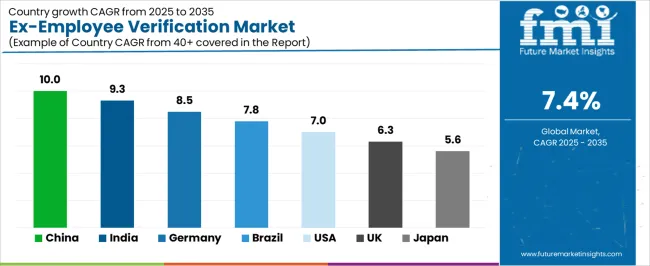
| Region/Country | 2025-2035 Growth | How to win | What to watch out |
|---|---|---|---|
| China | 10.0% | Focus on enterprise automation solutions | Regulatory changes; data localization |
| India | 9.3% | Lead with cost-effective processing | Compliance complexity; quality standards |
| Germany | 8.5% | Provide premium compliance services | Over-regulation; data protection laws |
| Brazil | 7.8% | Offer value-oriented solutions | Economic volatility; regulatory changes |
| United States | 7.0% | Push technology integration | Privacy regulations; scaling challenges |
| United Kingdom | 6.3% | Focus on regulatory compliance | Brexit impacts; compliance costs |
| Japan | 5.6% | Emphasize quality processing | Traditional preferences; adoption rates |
China establishes fastest market growth through aggressive corporate digitization programs and comprehensive employment screening industry expansion, integrating advanced verification systems as standard components in enterprise facilities and HR installations. The country's 10.0% growth rate reflects government initiatives promoting digital infrastructure and domestic verification capabilities that mandate the use of professional screening systems in corporate and government facilities. Growth concentrates in major business hubs, including Beijing, Shanghai, and Shenzhen, where corporate development showcases integrated verification systems that appeal to organizations seeking professional screening optimization capabilities and compliance applications.
Chinese providers are developing cost-effective verification solutions that combine domestic technology advantages with advanced processing features, including enhanced accuracy control and improved efficiency capabilities. Distribution channels through HR service providers and technology distributors expand market access, while government support for digital transformation supports adoption across diverse enterprise and government segments.
Strategic Market Indicators:
In Mumbai, Delhi, and Bangalore, enterprise facilities and corporate operators are implementing professional verification systems as standard equipment for compliance and risk management optimization applications, driven by increasing government regulatory investment and corporate modernization programs that emphasize the importance of professional screening capabilities. The ex-employee verification market holds a 9.3% growth rate, supported by government digital initiatives and corporate development programs that promote professional verification systems for enterprise and government facilities. Indian operators are adopting verification systems that provide consistent compliance assurance and efficiency features, particularly appealing in urban regions where risk management and operational excellence represent critical business requirements.
Market expansion benefits from growing technology capabilities and international corporate partnerships that enable domestic development of professional verification systems for enterprise and government applications. Technology adoption follows patterns established in HR technology, where reliability and accuracy drive procurement decisions and operational deployment.
Market Intelligence Brief:
Germany's advanced corporate market demonstrates sophisticated verification deployment with documented compliance effectiveness in enterprise applications and government facilities through integration with existing HR systems and operational infrastructure. The country leverages engineering expertise in technology and quality systems integration to maintain an 8.5% growth rate. Business centers, including Bavaria, Baden-Württemberg, and North Rhine-Westphalia, showcase premium installations where verification systems integrate with comprehensive HR platforms and compliance management systems to optimize screening effectiveness and operational outcomes.
German providers prioritize system quality and EU compliance in verification development, creating demand for premium systems with advanced features, including enterprise integration and professional compliance systems. The ex-employee verification market benefits from established corporate infrastructure and a willingness to invest in professional verification technologies that provide long-term operational benefits and compliance with international regulatory standards.
Market Intelligence Brief:
Brazil's market expansion benefits from diverse corporate demand, including business modernization in São Paulo and Rio de Janeiro, enterprise facility upgrades, and government digitization programs that increasingly incorporate professional verification solutions for compliance applications. The country maintains a 7.8% growth rate, driven by rising corporate activity and increasing recognition of professional verification benefits, including precise compliance control and enhanced operational effectiveness.
Market dynamics focus on cost-effective verification solutions that balance professional screening performance with affordability considerations important to Brazilian corporate operators. Growing business industrialization creates continued demand for modern verification systems in new corporate infrastructure and facility modernization projects.
Strategic Market Considerations:
United States establishes market leadership through comprehensive corporate programs and advanced HR infrastructure development, integrating verification systems across enterprise and government applications. The country's 7.0% growth rate reflects established corporate industry relationships and mature verification technology adoption that supports widespread use of professional screening systems in enterprise and government facilities. Growth concentrates in major business centers, including California, New York, and Texas, where verification technology showcases mature deployment that appeals to corporate operators seeking proven compliance capabilities and operational efficiency applications.
American corporate providers leverage established distribution networks and comprehensive technical support capabilities, including compliance programs and training support that create customer relationships and operational advantages. The ex-employee verification market benefits from mature regulatory standards and corporate requirements that mandate verification system use while supporting technology advancement and operational optimization.
Market Intelligence Brief:
United Kingdom's corporate market demonstrates integrated verification deployment with documented compliance effectiveness in enterprise applications and government facilities through integration with existing HR systems and operational infrastructure. The country maintains a 6.3% growth rate, supported by compliance excellence programs and screening effectiveness requirements that promote professional verification systems for corporate applications. Enterprise facilities across England, Scotland, and Wales showcase systematic installations where verification systems integrate with comprehensive HR platforms to optimize compliance and operational outcomes.
UK corporate providers prioritize system reliability and industry compatibility in verification procurement, creating demand for validated systems with proven compliance features, including quality monitoring integration and professional screening systems. The ex-employee verification market benefits from established corporate infrastructure and excellence requirements that support verification technology adoption and operational effectiveness.
Market Intelligence Brief:
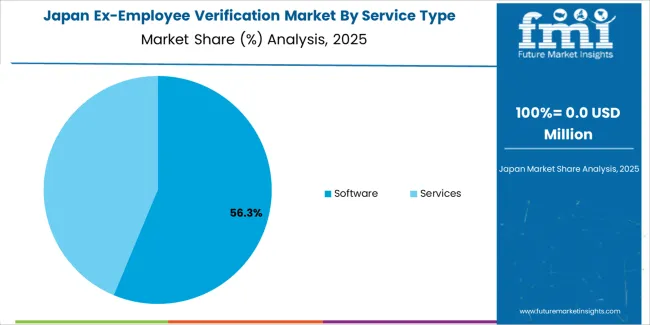
Japan's market growth benefits from precision corporate demand, including advanced enterprise facilities in Tokyo and Osaka, quality integration, and efficiency enhancement programs that increasingly incorporate verification solutions for compliance applications. The country maintains a 5.6% growth rate, driven by corporate technology advancement and increasing recognition of precision verification benefits, including accurate compliance control and enhanced efficiency outcomes.
Market dynamics focus on high-precision verification solutions that meet Japanese quality standards and compliance effectiveness requirements important to corporate operators. Advanced corporate technology adoption creates continued demand for sophisticated verification systems in enterprise facility infrastructure and efficiency modernization projects.
Strategic Market Considerations:
The European ex-employee verification market is projected to grow from USD 54.2 million in 2025 to USD 110.8 million by 2035, registering a CAGR of 7.4% over the forecast period. Germany is expected to maintain its leadership position with a 35.8% market share in 2025, supported by its advanced corporate infrastructure and major business centers.
United Kingdom follows with a 28.2% share in 2025, driven by comprehensive compliance programs and regulatory excellence development initiatives. France holds a 16.4% share through specialized corporate applications and compliance requirements. Italy commands a 11.9% share, while Spain accounts for 7.7% in 2025. The rest of Europe region is anticipated to gain momentum, expanding its collective share from 4.1% to 4.8% by 2035, attributed to increasing corporate adoption in Nordic countries and emerging business facilities implementing digitization modernization programs.
ex-employee-verification-market-analysis-by-company
| Stakeholder | What they actually control | Typical strengths | Typical blind spots |
|---|---|---|---|
| Global platforms | Technology infrastructure, broad service catalogs, enterprise relationships | Wide availability, proven accuracy, multi-region support | Service customization cycles; customer dependency on platform validation |
| Technology innovators | ai R&D; advanced automation technologies; enhanced processing capabilities | Latest technologies first; attractive ROI on verification effectiveness | Service density outside core regions; scaling complexity |
| Regional specialists | Local compliance, fast processing, nearby customer support | "Close to customer" support; pragmatic pricing; local regulations | Technology gaps; talent retention in customer service |
| Full-service providers | Complete verification programs, compliance services, enterprise integration | Lowest operational risk; comprehensive support | Service costs if overpromised; technology obsolescence |
| Niche specialists | Specialized industries, custom verification, compliance services | Win premium applications; flexible configurations | Scalability limitations; narrow market focus |
| Item | Value |
|---|---|
| Quantitative Units | USD 244.7 million |
| Service Type | Software, Services |
| Application | Large Enterprises, SMEs, Government |
| Industry | Financial Services, Healthcare, Technology, Manufacturing, Education |
| End Use | Corporations, Government Agencies, HR Service Providers, Consulting Firms, Background Check Companies |
| Regions Covered | North America, Latin America, Western Europe, Eastern Europe, East Asia, South Asia Pacific, Middle East & Africa |
| Countries Covered | China, India, Germany, Brazil, United States, United Kingdom, Japan, Canada, France, Australia, and 25+ additional countries |
| Key Companies Profiled | Authbridge, Gold Quest Global, Jellyfish Technologies, Indeed, Sutherland, Oracle, eLockr, CSM Technologies, Arc Attest |
| Additional Attributes | Dollar sales by service type and application categories, regional adoption trends across East Asia, North America, and Western Europe, competitive landscape with technology providers and verification specialists, enterprise operator preferences for verification effectiveness and compliance assurance, integration with HR platforms and compliance management systems, innovations in verification technology and automation enhancement, and development of advanced verification solutions with enhanced accuracy and operational optimization capabilities. |
The global ex-employee verification market is estimated to be valued at USD 244.7 million in 2025.
The market size for the ex-employee verification market is projected to reach USD 499.7 million by 2035.
The ex-employee verification market is expected to grow at a 7.4% CAGR between 2025 and 2035.
The key product types in ex-employee verification market are software and services.
In terms of application, large enterprises segment to command 60.0% share in the ex-employee verification market in 2025.






Full Research Suite comprises of:
Market outlook & trends analysis
Interviews & case studies
Strategic recommendations
Vendor profiles & capabilities analysis
5-year forecasts
8 regions and 60+ country-level data splits
Market segment data splits
12 months of continuous data updates
DELIVERED AS:
PDF EXCEL ONLINE
ID Verification Market
Identity Verification Market Analysis - Size, Share, and Forecast 2025 to 2035
Product Design Verification And Validation Solution Market Size and Share Forecast Outlook 2025 to 2035
Hardware-Assisted Verification Market Size and Share Forecast Outlook 2025 to 2035

Thank you!
You will receive an email from our Business Development Manager. Please be sure to check your SPAM/JUNK folder too.
Chat With
MaRIA